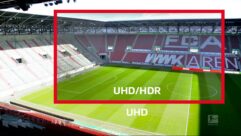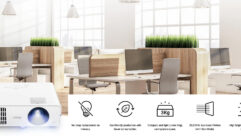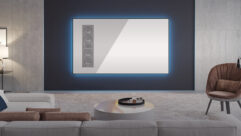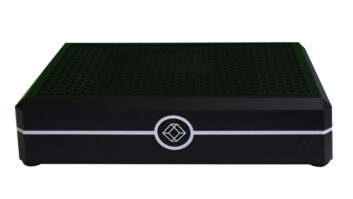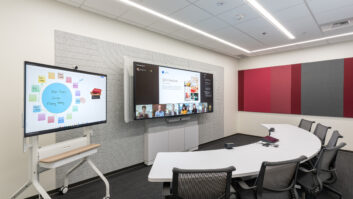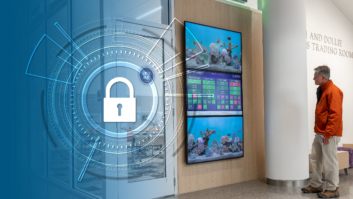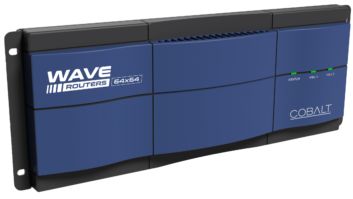In this edition of the SVC Podcast, SVC Contributing Editor Bennett Liles continues his talk with Ed Miscovic of The Light Brigade about fiber optic technology and training. Ed discusses the weight saving of fiber in remote trucks and temporary event setups. He also outlines the TIA-598 color coding scheme used to identify types of fiber and their specific capabilities. Ed also discusses the most important factors to consider in the specs for a new fiber system.
Links of interest:
• The Light Brigade in Tukwila, Washington – fiber optic systems training
• Fiber Optics 123 – A Light Brigade course on fiber optic network design, installation, and maintenance
• Fiber Optic Training DVDs
• Fiber Optics for Pro A/V and Broadcast “Hands-On” Training Course
Download Podcast Here:
https://s3.amazonaws.com/nb-svc/public/public/12_17_14-Light-Brigade_Mis…
Editor’s note: For your convenience, this transcription of the podcast includes timestamps. If you are listening to the podcast and reading its accompanying transcription, you can use the timestamps to jump to any part of the audio podcast by simply dragging the slider on the podcast to the time indicated in the transcription.
FromSound & Video Contractor Magazine, this is the SVC Podcast with Ed Miscovic and Larry Johnson from The Light Brigade. Show notes for the podcast are available on the web site ofSound & Video Contractor Magazineatsvconline.com.
Fiber optics are spreading through the AV industry and fiber training is more important now than ever. Ed Miscovic from The Light Brigade is back with us to talk about fiber color coding, emitters, detectors and Active Optical Cables. That’s up next on the SVC Podcast.
Ed thanks for being back with us for part two on the SVC Podcast from The Light Brigade with fiber training and certification. In part one we talked about fiber’s advantages and spec-ing out systems but when you’re considering a fiber transmission system for AV applications, what are the most important systems specs to consider for that or does it vary with a specific application?
Well it obviously would vary for the different applications. Some of the key parameters or key specifications that you want to be able to consider all the time would be the type and the quantity of the signals you have to transmit, whether it’s analog video or HD video, MADI audio. There’s all kinds of different signals associated in an AV. You might have some control signals that you want to get back and forth for either pan-tilt zoom, so there’s a lot of different types of signals that you can send both directions on fiber. You want to also then consider the bandwidth and the distances you have to go. You have a choice, obviously, between multi-mode and single-mode fiber and right now the AV industry still seems to prefer multi-mode fiber mainly, I think, because that’s where they grew up. They grew up in the environment of multi-mode fiber and it’s been adequate up until now. But now once you start getting into these very high bandwidth signals, now you have to start looking at single-mode fiber in lieu of traditional multi-mode fiber. You also have to consider the weight of your cable. Is this a permanent installation or is this something that some roadies are going to be throwing down and picking up after a given event. If you look at some of the specifications of fiber cable, a typical SMPTE cable, which is a composite cable, weighs around 24 pounds per thousand feet for 12 fibers, and that’s for a standard cable. If I want to go with a higher grade, higher durability type of a cable, like for a stadium cable, the weight, depending on how my layers of armor you might have in a jacketing material and so on, can go anywhere from 76 to 136 pounds for that same 12-fiber cable which is a thousand feet long. But in a normal environment that you might want to throw down for a typical event – like a concert and so on, fashion shows – the weight is quite light, 20-some pounds for a thousand feet for 12 fibers. And on 12 fibers, you can pretty much get anything you want from one end to the other on that cable. [Timestamp: 3:10]
And that weight difference can be a big factor when the fiber is being used in TV remote trucks both in the weight of hauling it all around, but also for saving a lot of wear and tear on the crew, putting all of that stuff out and hauling it all back in when the job is done.
Well it does, as you can see.Twenty-four pounds for a thousand feet is not that heavy at all so it makes it easier for laying the cable down and particularly pulling the cable back up after a long event, whether it’s a sporting event or a concert or whatever.You can do it quicker with a lot less fatigue. And knowing full well that the next time you have to deploy it, the only thing you may have to do might be to clean the connectors a little bit and then lay it down again and not have to worry about braids, for instance on a coax cable, breaking. So the reliability from one deployment to the next is greatly enhanced with the use of fiber as well. [Timestamp: 4:04]
And when you’re spec-ing a system out how much does the type of emitters and detectors and other specific components figure into the design? Do individual users really get into it that deeply?
Well they normally don’t have to. The equipment manufacturers have given specifications for emitters and detectors for their lasers and photo diodes, and they’ll typically run either on multi-mode or single-mode fiber. What you find in the AV market right now is there are still certain signals that are transmitted over multi-mode fiber and those are primarily HDMI and DVI and RGB. There isn’t a lot of RGB out there any more, but those are the three signals that typically get transmitted over multi-mode fiber. The reason for that is because there are multiple signals being transmitted on parallel fibers and the optics for that, it’s a very concentrated device. For example, they’ll have, for instance, four lasers in a very small package along with a wavelength multiplexer device built in a similar to like a dual inline package. So it’s a very small device that you can get using multi-mode lasers that will allow you to package that in a small and inexpensive package using the technology called VCSELs or vertical-cavity surface-emitting lasers. Those typically operate at the 850 nanometer range which are ideal for multi-mode fiber, whether it’s the traditional multi-mode fiber, the OM1 or OM2 as it’s come to be known, or the newer laser-optimized fiber which are called OM3 and OM4 fibers which give you much better performance over long distances in that 850 nanometer range. [Timestamp: 5:44]
I’ve noticed that the evolution of the connectors on the cables has been substantial. In the earlier days of fiber one of the weak links in the system was always going to be the connectors which were fairly fragile but now they have connectors that are just as tough as the copper gear. Has that evolution happened just over the past ten years or so?
Yeah, there’s a lot of good optical connectors out there now. Some of them are hermaphroditic, which would be the tactical fiber cables. So when you’re deploying a cable you don’t have to worry about which end you’re deploying first because it’s a hermaphroditic connector. They will mate with themselves basically, so you don’t have to worry about having the left side being crossed over to the right side and so on. But in the AV market and in the broadcast market they have come out with standardized connectors which are standardized by SMPTE, the standards committee for SMTE. And those include both fiber-only connectors or they include a composite cable where I can have a standard – for instance a standard SMPTE 292 connector would have two fibers, it would have two signal wires and then two power wires so I can run my camera from those two power wires. I can control the camera or use it for a tally light or whatever I wanted to use those signal wires for and then I can transmit my video – my high-bandwidth video – over the fibers so I can go longer distances, I can combine all of those signals into one cable. [Timestamp: 7:14]
And all of those signals that use the copper parts of the cable tend to be the ones that can go the longer distance over the copper.
Right. Those would be the low data-rate signals, whether it’s maybe an audio signal or maybe it’s a control signal, a contact closure. Whatever it might be, those are the low data-rate, low bandwidth signals. So you can go long distances on that and you save your high bandwidth signals, like for instance your HD video, to send over the fiber. [Timestamp: 7:41]
Explain to us a little about the Active Optical Cables.
Sure, be glad to. Active Optical Cables are essentially fiber optic cables. They’re preterminated with the transmitter and receiver or transceivers on each end. And typically you would find this with a multi-mode application where you have multi-mode fibers in there using signals to transmit signals such as HDMI, DVI, Thunderbolt and DiplayPort. Those are the primary types of signals to use with Active Optical Cables. Basically it’s digital signal transmission, digital video transmission, over fiber and it’s typically, again, using multi-mode fibers.Because of this integrated optical device, this wavelength multiplex device that uses a few lasers in the 850 nanometer range, and then multiplexes those together within the small package. So it’s a very cost-effective method to do it and you can get 50, 100 meters, 150 meters or so on depending on, again, the type of signal you’re trying to transmit and the type of multi-mode fiber you use. If you use OM1 fiber your distances are very limited, maybe to 25 meters or so. But yet if I start to use OM3 or OM4 fiber on that Active Optical Cable I might be able to go several hundred meters, which again in a lot of instances is good enough. It’s long enough to go from the front of the stage to the back of the stage or from the stage to the back of the concert hall where your video and audio mixers are. So there’s a lot of applications where these Active Optical Cables sit very nicely where I don’t have to have large transmission equipment connected at the ends; where this is just a simple link all by itself with the electronics on each end and the optical cable in the middle. So it provides another alternative in some of these quick throw down installations to get your cables and your equipment down very quickly. [Timestamp: 9:36]
And one of the more creative aspects of this that the manufacturers have adopted is the color coding. Some of the cables and the connector jackets have a color-coding scheme that really saves time and prevents errors.
Well the color coding comes form the TIA standard 598 and what you find is that there are standard colors for fibers inside the jackets. For example, the OM1 fiber, which is a standard 62.5 micron multi-mode fiber and the standard 50 micron fiber is the OM2. Those have an orange jacket. The OM3, which is a laser-optimized fiber, has an aqua jacket, and again that’s a multi-mode fiber. And then the fourth multi-mode fiber, which is an OM4 laser-optimized fiber, has a new color called heather violet. This single-mode, on the other hand, has a yellow jacket so when you’re doing an installation and you see these patch cords of these various colors you know immediately what type of fiber is inside that jacket so you know what to hook up to it, so it makes installation a lot easier. On the connector side they have different color connectors depending on the type of polish that the fiber end face has. For example, a standard multi-mode fiber which has a flat polish on it may have either like a beige or a black type of a boot, or if it’s a plastic connector it’ll be a black or a beige type of connector. On single-mode fibers, if it has an angle polish connector it will be green or if it has an ultra-physical contact connector or polish on it, which is called a UPC, that would have a blue finish on it. Again if it’s a plastic connector like an SC or an LC, the connector itself would have that color, otherwise the boot – the strain relief boot on the back of the connector – would be color-coded thusly. So you know again when you’re deploying these things you know what to plug in where and what kind of fiber to interface it with to make the installation a whole lot easier and a lot faster. [Timestamp: 11:40]
And of course all of that is part of the fiber training you can get at The Light Brigade. I thought we had passed all the color coding back in the resistor banding days but I guess that’s going to stay with us and it probably comes in very handy when you’re dealing with fiber systems.
Well and then in the cable itself they are color coded. Each buffer tube is color coded and each fiber within that buffer tube, if you have a standard 12-fiber buffer tube each one of those buffered fibers in there would have a color code on its coating and then each buffer tube inside the cable would also have a color code so you can know exactly, if somebody says I need to go to fiber 44, you know exactly what fiber to look for in what specific buffer tube. So again it makes identifying fibers much, much easier whether it’s inside the cable itself or whether you’re trying to connect it to your peripheral equipment. [Timestamp: 12:34]
Well, there’s a lot to it and all of this points up the fact that having the proper fiber optic training is more important today than it’s ever been and The Light Brigade is a good source for that training. It’s been great having you here, Ed, and you guys to great work out there and thanks for being with us.
Thank you.
Thank you for being here with us for the SVC Podcast with Ed Miscovic and Larry Johnson of The Light Brigade. Show notes are available on the website ofSound & Video Contractor Magazineatsvconline.com. Be with us again next time on the SVC Podcast.


